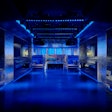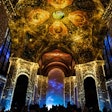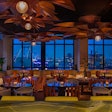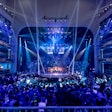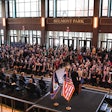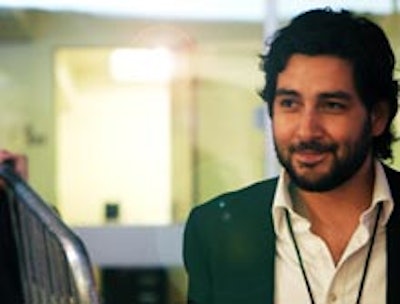
Dalzell's Joshua Cicerone
Photo: Courtesy of Andrew Federman
The Tribeca Film Festival is one of the bigger undertakings on New York’s entertainment calendar, kicking off tomorrow and running through May 4. No longer just an excuse to bring excitement and revenue to post-9/11 TriBeCa, the festival has grown into an attractive showcase for both major studio releases and unsigned independent films. This year’s 920 screenings include work from 41 countries and 110 independent films that will be looking for distributors.
Behind it all, tasked with making sure things don't spiral out of control, is the small team at Dalzell Productions. They’ve been working closely with the festival since Year One, and to pull it off this year, they’ll be enlisting 300 volunteers and clocking a total of 4,800 man-hours. On their docket: everything from 25 gala premieres at the Tribeca Performing Arts Center to public events like the three-night drive-in outdoor screenings. On the eve of this marathon, we asked Dalzell vice president and creative director Joshua Cicerone how they do it and what's changing this year.
The Tribeca Film Festival has grown a lot since it debuted in 2002. How has preparing for it evolved over the years?
I’ve been on it for seven years myself. The first year it came out of nowhere, but because of the urgency of 9/11, it was an appropriate response for the neighborhood. We only had eight or nine weeks to plan it, so we were in panic mode the whole time. Now the panic is a thing of the past, so we can take our time. Every year there is something new, some new program. Having a team that has worked on the festival each year with me has been invaluable. It’s 13 days, and it’s bound to fatigue you.How do you make such a huge, scattered project come across as one cohesive event?
A lot of that has to do with the branding. We work very closely with Ogilvy to create a logo that can tie it all together. It seems to have gotten simpler and simpler. This year you’ll notice there’s a spiral that harkens a psychedelia and the color magenta. You’ll see them both on all signage.
Another thing is the attitude of the staffers. It’s one of respect. Everyone who is on the staff, wearing the badges, has an energy and spirit to them. You know you’re near a Tribeca event because there’s a glimmer in the eyes of the people working.
The festival takes over a large part of the city. How do you work with city agencies to make sure the event runs smoothly?
I think the most important is the union labor at Local One—the carpenters, stagehands, and riggers. In terms of safety, we rely on them completely, and there is no one better to work with on a short schedule. They look forward to the event, and we look forward to working with them. It helps to have their professionalism.
On the city level, we work very closely with the Department of Transportation and the N.Y.P.D. We used to be more involved with the Downtown Alliance and the Lower Manhattan Cultural Council, but it’s more of a political relationship now.
Have the rocky financial climate and budgetary concerns played a role in the festival’s execution this year?
It’s affected our gala planning a little. I think there’s a need to not be frivolous and the need to not come across as frivolous right now, so in terms of big gala parties, there are fewer. I think that makes sense. In a climate like this, you don’t want to seem like you’re rubbing it in the people’s faces. We haven’t cut any corners when it comes to public events, though. As long as you maintain those, it’s the private things that take a backseat, and I’m just fine with that.
How do you work with the festival’s organizers during the planning?
Incredibly closely. This year we started working with the new co-executive directors, Nancy Schafer and Paola Freccero, and we consider them partners. In my office, I work hand in hand with our production director, Jared Siegel . We’re in cahoots with Nancy and Paola on the phone every day. We’ve been working together for so long, they’ve come to think of us as overall strategic partners. They’ve come to trust us to run something that always looks great.
What is a typical day for you during the festival?
"Chaos" is the short answer. It’s waking up early and getting caught up in the office in the first few hours of the morning. We look at things in three-day chunks of time, because that’s how long it takes each project from start to finish. I’ve learned how to master being in six places at once and deal with changes happening on the fly. The week of the festival, things change often. Having a big team that has done this and knows how to roll with the punches is invaluable.
If you had to summarize the goals for Tribeca 2008 in one or two sentences, what would you say?
It’s really about bringing entertainment to the people of the city and bringing in more international films, public events, and things that feel inclusive. At this point in history, tolerance and inclusivity are so important, and that‘s what the festival tries to express, from its film selection to the public events.
Correction: This story has been updated to correct the spelling of Jared Siegel's name.
Behind it all, tasked with making sure things don't spiral out of control, is the small team at Dalzell Productions. They’ve been working closely with the festival since Year One, and to pull it off this year, they’ll be enlisting 300 volunteers and clocking a total of 4,800 man-hours. On their docket: everything from 25 gala premieres at the Tribeca Performing Arts Center to public events like the three-night drive-in outdoor screenings. On the eve of this marathon, we asked Dalzell vice president and creative director Joshua Cicerone how they do it and what's changing this year.
The Tribeca Film Festival has grown a lot since it debuted in 2002. How has preparing for it evolved over the years?
I’ve been on it for seven years myself. The first year it came out of nowhere, but because of the urgency of 9/11, it was an appropriate response for the neighborhood. We only had eight or nine weeks to plan it, so we were in panic mode the whole time. Now the panic is a thing of the past, so we can take our time. Every year there is something new, some new program. Having a team that has worked on the festival each year with me has been invaluable. It’s 13 days, and it’s bound to fatigue you.How do you make such a huge, scattered project come across as one cohesive event?
A lot of that has to do with the branding. We work very closely with Ogilvy to create a logo that can tie it all together. It seems to have gotten simpler and simpler. This year you’ll notice there’s a spiral that harkens a psychedelia and the color magenta. You’ll see them both on all signage.
Another thing is the attitude of the staffers. It’s one of respect. Everyone who is on the staff, wearing the badges, has an energy and spirit to them. You know you’re near a Tribeca event because there’s a glimmer in the eyes of the people working.
The festival takes over a large part of the city. How do you work with city agencies to make sure the event runs smoothly?
I think the most important is the union labor at Local One—the carpenters, stagehands, and riggers. In terms of safety, we rely on them completely, and there is no one better to work with on a short schedule. They look forward to the event, and we look forward to working with them. It helps to have their professionalism.
On the city level, we work very closely with the Department of Transportation and the N.Y.P.D. We used to be more involved with the Downtown Alliance and the Lower Manhattan Cultural Council, but it’s more of a political relationship now.
Have the rocky financial climate and budgetary concerns played a role in the festival’s execution this year?
It’s affected our gala planning a little. I think there’s a need to not be frivolous and the need to not come across as frivolous right now, so in terms of big gala parties, there are fewer. I think that makes sense. In a climate like this, you don’t want to seem like you’re rubbing it in the people’s faces. We haven’t cut any corners when it comes to public events, though. As long as you maintain those, it’s the private things that take a backseat, and I’m just fine with that.
How do you work with the festival’s organizers during the planning?
Incredibly closely. This year we started working with the new co-executive directors, Nancy Schafer and Paola Freccero, and we consider them partners. In my office, I work hand in hand with our production director, Jared Siegel . We’re in cahoots with Nancy and Paola on the phone every day. We’ve been working together for so long, they’ve come to think of us as overall strategic partners. They’ve come to trust us to run something that always looks great.
What is a typical day for you during the festival?
"Chaos" is the short answer. It’s waking up early and getting caught up in the office in the first few hours of the morning. We look at things in three-day chunks of time, because that’s how long it takes each project from start to finish. I’ve learned how to master being in six places at once and deal with changes happening on the fly. The week of the festival, things change often. Having a big team that has done this and knows how to roll with the punches is invaluable.
If you had to summarize the goals for Tribeca 2008 in one or two sentences, what would you say?
It’s really about bringing entertainment to the people of the city and bringing in more international films, public events, and things that feel inclusive. At this point in history, tolerance and inclusivity are so important, and that‘s what the festival tries to express, from its film selection to the public events.
Correction: This story has been updated to correct the spelling of Jared Siegel's name.









